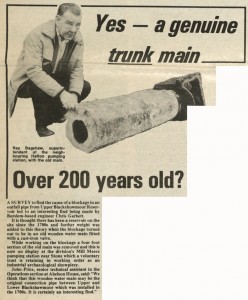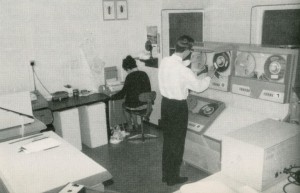May 15, 2012, by Sarah Colborne
A year immersed in water records
This month I have come to the end of a year spent appraising, arranging and describing over 500 boxes of archive material relating to water, in my role as cataloguing archivist for Manuscripts and Special Collection’s Water Records Project.
It has been quite a task, wrestling with rolled up plans, unwrapping packets of mysterious meteorological and hydrological data, and getting to grips with the complicated and constantly changing administrative structure of a sector whose operations are essential to life on our planet.
I’ve come to appreciate the scale of the work which goes on behind the scenes to ensure that we have a safe and sufficient supply of water, from the controversial building of dams and reservoirs to the daily grind of maintaining the infrastructure of mains pipes which lie unnoticed beneath our feet.

Cutting from the Severn Trent Water Authority's staff newspaper showing the discovery of a 200 year old trunk main
I’ve also been impressed by the efforts taken by the Trent River Authority and its predecessor bodies, following the severe flooding in the 1930s of Nottingham’s spreading urban areas, to gain an understanding of the role played by environmental and man-made factors, in order to prevent future devastation. It’s a sector which is largely taken for granted, until extreme weather conditions remind us of our reliance on the efficient management of water resources.
Those interested in finding out more about the water archives held by the University can now access over 26 000 catalogue descriptions via Manuscripts and Special Collections online catalogue (browse collections by the subject ‘Rivers, drainage and water records’).
No comments yet, fill out a comment to be the first


Leave a Reply